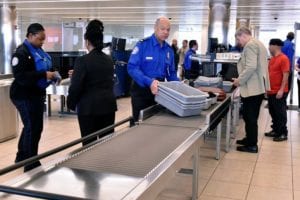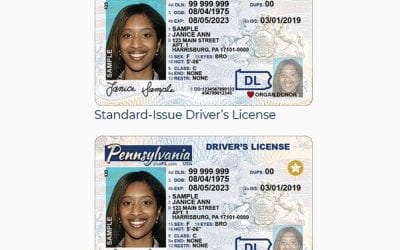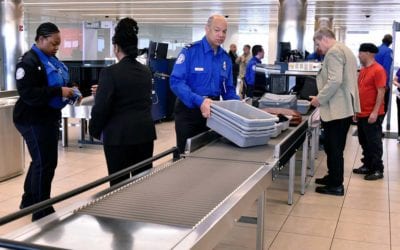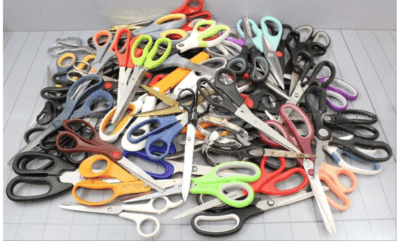The COVID-19 pandemic has caused big TSA changes for ID protocols, the use of bins, and hand sanitizer in carry-ons when they fly.
 When you arrive, you’re in for some surprises at Transportation Security Administration (TSA) checkpoints. There are new big TSA changes being made to protect the flying public and TSA Transportation Security Officers (TSOs). These new rules are just now being implemented.
When you arrive, you’re in for some surprises at Transportation Security Administration (TSA) checkpoints. There are new big TSA changes being made to protect the flying public and TSA Transportation Security Officers (TSOs). These new rules are just now being implemented.
Some of the big TSA changes are helpful to passengers. Some make things more difficult for passengers if they don’t pack smart. Most of the rules from the past remain, though a few have newly instituted exceptions.
Here’s what to look for at the airport TSA checkpoint
Food from home:
If you’re bringing food from home to eat during your flight you’ll need to place it in a clear plastic bag. This will enable it to be inspected at TSA security checkpoints. If you want to wrap it first, make sure you use clear plastic wrap, not aluminum foil or other wrapping material that isn’t transparent.
READ ALSO ON THE TRAVELERS UNITED BLOG:
Keep belongings safe and secure at the airport
When TSA discovers a passenger with a temperature above 100.4° Fahrenheit, what’s next?
Social distancing and face masks are required at TSA checkpoints
Face Masks & Social Distancing:
Follow local and state rules and regulations in the airport for face masks and social distancing. In addition, most airports have installed floor markings for TSA airport checkpoint lines. Use them. If you don’t, you’ll be “gently” asked to follow them. A few air travelers have told me they were directed to the back of the line when they ignored their social distancing request.
In order to identify you, it’s possible for a TSA TSO to ask you to remove or pull down your face mask. You’ll need to comply with the request.
Touchless Security Boarding Pass Scanning:
At the TSA checkpoint, don’t hand your boarding pass to the TSA TSO. Scan it yourself. Then hold it up for the TSO to inspect it without touching it. You’ll need to give the TSO your photo identification, as they need to check if it’s a forgery and match the photo to your face.
You don’t need a REAL ID-compliant identification to fly domestically, at this time. Due to the COVID-19 pandemic, the Department of Homeland Security postponed REAL ID compliance to October 1, 2021. Many state departments of motor vehicles have been closed since March. As a result, an expired driver’s license or other state-issued photo identification may be used. TSA will continue to accept the expired state-issued IDs up to a year after their expiration or 60 days after the COVID-19 emergency ends, whichever is longer.
Exceptions to TSA’s 3-1-1 Liquids Rule
3–1–1 Liquids Rule:
The TSA 3–1–1 liquid rule is still in place, with two COVID-19 pandemic exceptions. The rule still requires that liquid containers must not exceed 3.4 ounces (100 ml) per container and all containers must fit into a single, one quart-sized resealable bag. The liquids bag now should be packed in your carry-on unless otherwise requested for separate inspection. This is another touchless security change.
In addition to 3–1–1 compliant liquids, TSA is permitting each passenger to pack a single 12-ounce container of liquid hand sanitizer in their carry-on. You may be asked to take the container of hand sanitizer out of your carry-on for inspection. In addition, TSA is permitting passengers to bring pre-moistened wipes in their carry-ons without size restriction. Like the hand sanitizer, a TSO may require you to remove the wipes from your carry-on for inspection. Neither of these items impacts the 3–1–1 liquids quantity restriction. Other countries may not institute the same exceptions.
Electronic Gear:
Laptops and other large electronic gear should now remain in your carry-on. If it triggers an alarm by the x-ray they may require a hand inspection, if necessary.
Pack defensively in layers, with anything having wires in one layer only. That way, they are more easily identifiable in the first pass of your carry-on through x-ray. If you stack your gear it makes it extremely difficult to identify the packed items in your bag, virtually ensuring a delay in getting through the TSA security checkpoint.
TSA is attempting to reduce bin use to minimize contamination of passengers’ belongings
Keys, cellphones, wallets, loose change, and other miscellaneous items:
To minimize contamination of your personal items normally kept in your pockets, place these items in your carry-on, not in their bins. I keep a couple of reusable cloth bags in the outer pocket of my carry-on to keep these items safe.
TSA agent’s gloves:
Agents are supposed to change their gloves between passengers to hand check their carry-on or before they patdown passengers. If they forget to do so, request them to change their gloves before they pat you down or check your carry-on.
To get through TSA security checkpoints with a minimum of delay and hassle, comply with the new rules and protocols. Plus, pack defensively. Air travel is difficult enough without self-inflicted delays and distress.
After many years working in corporate America as a chemical engineer, executive and eventually CFO of a multinational manufacturer, Ned founded a tech consulting company and later restarted NSL Photography, his photography business. Before entering the corporate world, Ned worked as a Public Health Engineer for the Philadelphia Department of Public Health. As a well known corporate, travel and wildlife photographer, Ned travels the world writing about travel and photography, as well as running photography workshops, seminars and photowalks. Visit Ned’s Photography Blog and Galleries.



